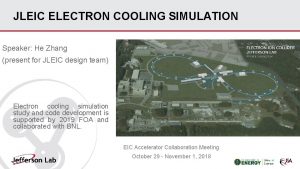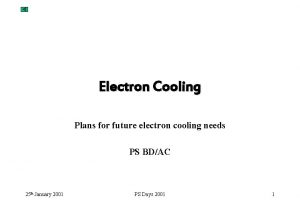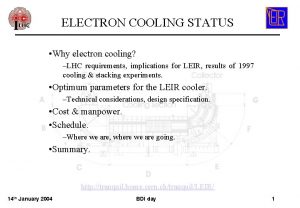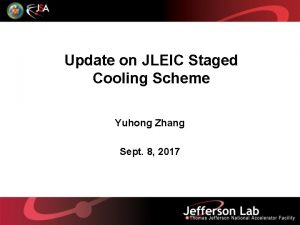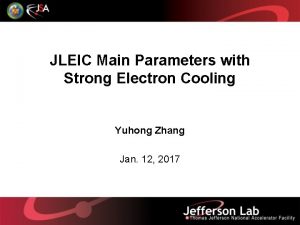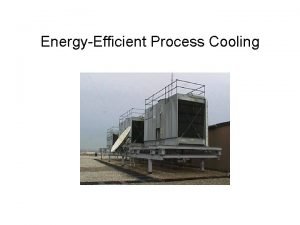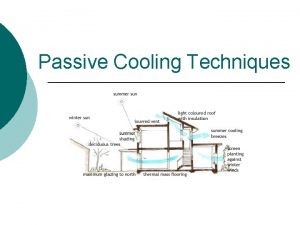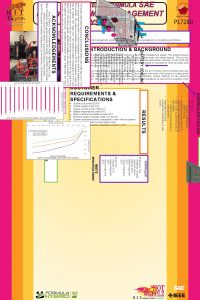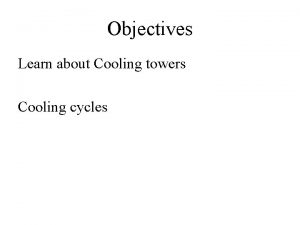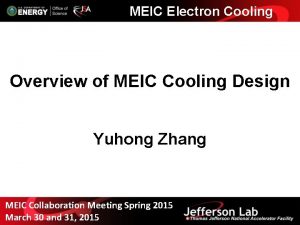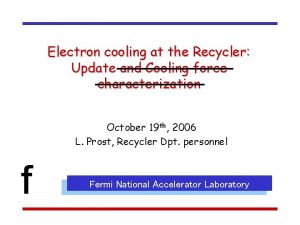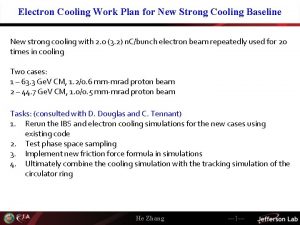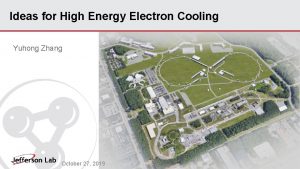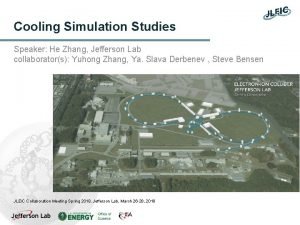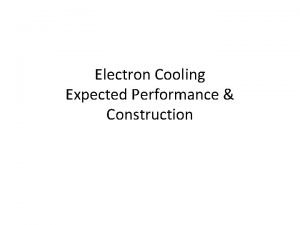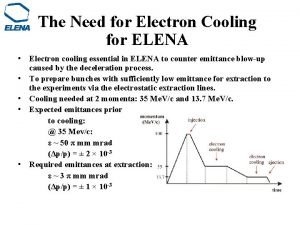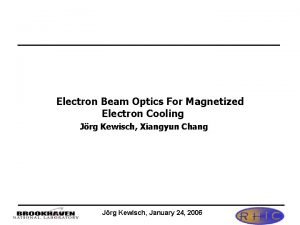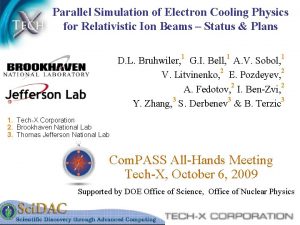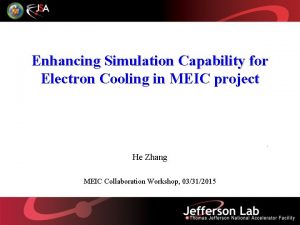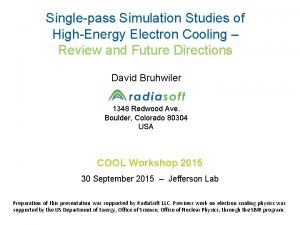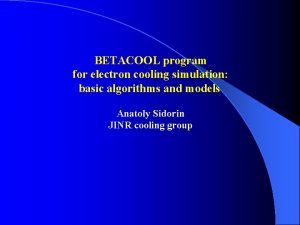Electron Cooling Simulation For JLEIC He Zhang JLEIC

























- Slides: 25

Electron Cooling Simulation For JLEIC He Zhang JLEIC Collaboration Meeting, 04/03/2017 Newport News, VA

Outline • Two–stage electron cooling scheme for JLEIC • Electron cooling simulation for JLEIC new baseline • Turn-by-turn tracking simulation for electron cooling • Summary He Zhang ---2 ---

JLEIC Staged Cooling Scheme JLEIC ion complex layout He Zhang ---3 ---

Outline • Two–stage electron cooling scheme for JLEIC • Electron cooling simulation for JLEIC new baseline • Turn-by-turn tracking simulation for electron cooling • Summary He Zhang ---4 ---

DC Cooling at the Booster Proton beam: KE = 2 Ge. V Emit = 2. 15 mm mrad dp/p = 0. 001 N = 2. 8 E 12 IBS ECOOL IBS+ECOOL RH 1/s 3. 86 E-4 -9. 05 E-3 -9. 10 E-3 RV 1/s 3. 86 E-4 -9. 00 E-3 -8. 71 E-3 RL 1/s 2. 27 E-4 -15. 3 E-3 Electron beam: I=2 A Ttr = 0. 1 e. V, Ts = 0. 1 e. V DC cooler: L = 10 m B=1 T He Zhang ---5 ---

JLEIC New Baseline Parameters He Zhang --6 --

Beam Parameters (CM Energy 63. 5 Ge. V) o Proton beam (CM energy 63. 5 Ge. V): § Energy: 100 Ge. V § Bunch size (rms): 0. 835/0. 835 mm § Proton number: 3. 9 x 1010 § Normalized emit. (rms): 1. 25/0. 25 μm § Momentum spread: 8 x 10 -4 § Beta function in cooler: 60/300 m § Bunch length (rms): 2. 5 cm o Cooler parameters: § Length: 2 x 30 m § B = 1 T o Cooling electron beam: § Charge: 2. 0 (3. 2) n. C § Momentum spread: 6 x 10 -4 § Bunch length (total length): 2 cm § Longitudinal temperature: 0. 184 e. V § Larmor emittance: 19 μm § Radius: 0. 835 mm § Transverse temperature: 0. 246 e. V § Length: 2 cm § Beta function in cooler: 36. 67 cm He Zhang ---7 ---

Electron Cooling (CM Energy 63. 5 Ge. V) Proton beam (CM energy 63. 5 Ge. V) Electron beam 2 n. C Cooling rate 10 -3 1/s -0. 280 -0. 961 -0. 537 IBS rate 10 -3 1/s 3. 192 0. 102 0. 618 Total rate 10 -3 1/s 2. 912 -0. 857 0. 081 Electron beam 3. 2 n. C Cooling rate 10 -3 1/s -0. 428 -1. 456 -0. 817 IBS rate 10 -3 1/s 3. 192 0. 102 0. 618 Total rate 10 -3 1/s 2. 764 -1. 354 -0. 199 • In horizontal direction, cooling is about one order weaker than IBS. In the other two directions, cooling is stronger To find equilibrium: Apply dispersion at cooler to transfer longitudinal cooling to transverse directions Apply transverse coupling to transverse horizontal IBS to vertical direction Increase proton beam emittance Decrease proton beam current • • He Zhang ---8 ---

Electron Cooling (CM Energy 63. 5 Ge. V) o Proton beam (CM energy 63. 5 Ge. V): § Bunch size (rms): 0. 835/0. 835 mm § Energy: 100 Ge. V § Momentum spread: 8 x 10 -4 § Proton number: 9. 975 x 109 (25%) § Bunch length (rms): 2. 5 cm § Normalized emit. (rms): 1. 25/0. 38 μm § Dispersion at cooler: 2. 0/0. 2 m § Beta function in cooler: 60/200 m § Transverse coupling: 40% Electron beam 2. 0 n. C He Zhang ---9 ---

Electron Cooling (CM Energy 63. 5 Ge. V) o Proton beam (CM energy 63. 5 Ge. V): § § Energy: 100 Ge. V § § Proton number: 1. 482 x 1010 (38%) § § Normalized emit. (rms): 1. 25/0. 38 μm § § Beta function in cooler: 60/200 m § Bunch size (rms): 0. 835/0. 835 mm Momentum spread: 8 x 10 -4 Bunch length (rms): 2. 5 cm Dispersion at cooler: 2. 0/0. 2 m Transverse coupling: 38% Electron beam 3. 2 n. C He Zhang ---10 ---

Beam Parameters (CM Energy 44. 7 Ge. V) o Proton beam (CM energy 44. 7 Ge. V): § Energy: 100 Ge. V § Proton number: 0. 98 x 1010 § Normalized emit. (rms): 0. 5/0. 1 μm § Beta function in cooler: 60/300 m o Cooler parameters: § Length: 2 x 30 m § B = 1 T o Cooling electron beam: § Charge: 2. 0 (3. 2) n. C § Bunch length (total length): 2 cm § Larmor emittance: 19 μm § Transverse temperature: 0. 246 e. V § Beta function in cooler: 36. 67 cm § § § § He Zhang Bunch size (rms): 0. 528/0. 528 mm Momentum spread: 8 x 10 -4 Bunch length (rms): 1 cm Momentum spread: 6 x 10 -4 Longitudinal temperature: 0. 184 e. V Radius: 0. 528 mm Length: 2 cm ---11 ---

Electron Cooling (CM Energy 44. 7 Ge. V) Proton beam (CM energy 44. 7 Ge. V) Electron beam 2 n. C Cooling rate 10 -3 1/s -3. 113 -7. 817 -3. 665 IBS rate 10 -3 1/s 12. 894 0. 669 0. 992 Total rate 10 -3 1/s 9. 781 -7. 148 -2. 673 Electron beam 3. 2 n. C • • • Cooling rate 10 -3 1/s -4. 708 -11. 787 -0. 554 IBS rate 10 -3 1/s 12. 894 0. 669 0. 992 Total rate 10 -3 1/s 8. 186 -11. 118 -0. 455 In horizontal direction, cooling is much weaker than IBS. In the other two directions, cooling is much stronger. Pay attention to longitudinal overcooling. Apply dispersion at cooler to transfer longitudinal cooling to transverse directions Apply transverse coupling to transverse horizontal IBS to vertical direction Increase proton beam emittance Decrease proton beam current He Zhang ---12 ---

Electron Cooling (CM Energy 44. 7 Ge. V) o Proton beam (CM energy 44. 7 Ge. V): § Energy: 100 Ge. V § Proton number: 0. 539 x 1010 (55%) § Normalized emit. (rms): 0. 50/0. 15 μm § Beta function in cooler: 60/200 m § § § Bunch size (rms): 0. 528/0. 528 mm Momentum spread: 8 x 10 -4 Bunch length (rms): 1. 5 cm Dispersion at cooler: 1. 7/0. 35 m Transverse coupling: 40% Electron beam 2. 0 n. C He Zhang ---13 ---

Electron Cooling (CM Energy 44. 7 Ge. V) o Proton beam (CM energy 44. 7 Ge. V): § Energy: 100 Ge. V § Proton number: 0. 804 x 1010 (82%) § Normalized emit. (rms): 0. 50/0. 15 μm § Beta function in cooler: 60/200 m § § § Bunch size (rms): 0. 528/0. 528 mm Momentum spread: 8 x 10 -4 Bunch length (rms): 1. 5 cm Dispersion at cooler: 1. 8/0. 4 m Transverse coupling: 40% Electron beam 3. 2 n. C He Zhang ---14 ---

Outline • Two–stage electron cooling scheme for JLEIC • Electron cooling simulation for JLEIC new baseline • Turn-by-turn tracking simulation for electron cooling • Summary He Zhang ---15 ---

Compare the Tracking Results of Electron Cooling • Turn-by-Turn tracking 1. 2. 3. 4. 5. Create particles w. r. t. the original emittances of the ion beam. Calculate the friction force, which leads to a momentum change (a kick), on each ion. Apply the linear one-turn-map (generated from the tunes) on all the particles Emittances are calculated statistically from the 6 D phase space coordinates of all the particles. Repeated from step 1. q The turn-by-turn tracking is more “fundamental” than the RMS dynamic simulation. In the following we compare the results of the two methods, to check the accuracy of the RMS dynamic simulation He Zhang --16 --

Beam Parameters (CM Energy 63. 5 Ge. V) o Proton beam (CM energy 63. 5 Ge. V): § Energy: 100 Ge. V § Bunch size (rms): 0. 835/0. 835 mm § Proton number: 9. 975 x 109 § Normalized emit. (rms): 1. 25/0. 38 μm § Momentum spread: 8 x 10 -4 § Beta function in cooler: 60/200 m § Bunch length (rms): 2. 5 cm o Cooler parameters: § Length: 2 x 30 m § B = 1 T o Cooling electron beam: § Charge: 2. 0 n. C § Momentum spread: 6 x 10 -4 § Bunch length (total length): 2 cm § Longitudinal temperature: 0. 184 e. V § Larmor emittance: 19 μm § Radius: 0. 835 mm § Transverse temperature: 0. 246 e. V § Length: 2 cm § Beta function in cooler: 36. 67 cm q IBS effect NOT included. q Zero dispersion at the cooler q Proton beam (Gaussian) size larger than electron beam (Beer can) size He Zhang ---17 ---

Compare the Tracking Results of Electron Cooling • Tracking 10, 000 protons for one second (139, 181 turns) Initial 1. 2499713 0. 3799988 8. 0000000 2. 5000000 RMS 1 1. 2496505 0. 3797225 7. 9980180 2. 4993806 Track 1. 2496698 0. 3797232 7. 9980328 2. 4993852 Error 1. 54× 10 -5 1. 74× 10 -6 1. 85× 10 -6 5. 70% 0. 63% 0. 67% Err. 1 hr 2 Initial × 10 -4 -2. 56627 -7. 27271 -4. 95561 Track 3 × 10 -4 -2. 41220 -7. 25535 -4. 91862 0. 0639 0. 0024 0. 0075 Error He Zhang --18 --

Compare the Tracking Results of Electron Cooling • Tracking 10, 000 protons for ten second (1, 391, 803 turns) Initial 1. 2499547 0. 3799763 8. 0000000 2. 5000000 RMS 1 1. 2467795 0. 3772010 7. 9811745 0. 0249412 Track 1. 2466268 0. 3770856 7. 9800944 2. 4937795 Error 1. 22× 10 -4 3. 06× 10 -4 1. 35× 10 -4 4. 51% 11. 65% 4. 99% Err. 1 hr 2 Initial × 10 -4 -2. 54352 -7. 33049 -4. 71193 Track 3 × 10 -4 -2. 66595 -7. 63655 -4. 98261 0. 0459 0. 0401 0. 0543 Error He Zhang --19 --

Compare the Tracking Results of Electron Cooling • Tracking 100, 000 protons for one second (139, 181 turns) • Tracking 100, 000 protons for ten second (1, 391, 803 turns) Initial 1. 2499993 0. 3799999 8. 0000000 2. 5000000 Initial 1. 2499853 0. 3800000 8. 0000000 2. 5000000 RMS 1 1. 2496692 0. 3797223 7. 9979911 2. 4993722 RMS 1 1. 2466963 0. 3772022 7. 9800249 2. 4937578 Track 1. 2496698 0. 3797232 7. 9980018 2. 4993756 Track 1. 2466379 0. 3771630 7. 9800219 2. 4937568 Error 5. 05× 10 -7 2. 42× 10 -6 1. 34× 10 -6 Error 4. 69× 10 -5 1. 04× 10 -4 3. 84× 10 -7 0. 18% 0. 88% 0. 49% 1. 70% 3. 81% 0. 28% Err. 1 hr 2 Initial × 10 -4 -2. 64114 -7. 30810 -5. 02295 Initial × 10 -4 -2. 63464 -7. 38990 -5. 00001 Track 3 × 10 -4 -2. 63609 -7. 28386 -4. 99607 Track 3 × 10 -4 -2. 68150 -7. 49383 -5. 00078 0. 0019 0. 0033 0. 0054 0. 0175 0. 0139 0. 0002 Error He Zhang --20 --

Compare the Tracking Results of Electron Cooling Max Error of Emit. For One Step Size N=10, 000 N=100, 000 Δt=1 s 1. 54× 10 -5 2. 42× 10 -6 Δt=10 s 3. 06× 10 -4 1. 04× 10 -4 Max Accu. Error of Emit. in One Hour N=10, 000 N=100, 000 Δt=1 s 5. 70% 0. 88% Δt=10 s 11. 65% 3. 81% Previous results are summarized in the tables on the left side, we can see: q The smaller the time step is, the smaller the error we get. q The larger the number of particles is, the smaller the error we get. q If we use step size no more than one second, and number of particles no less than 100, 000, the simulation results should be accurate enough (at least for now). q Note that we assume the friction force calculation is correct, and the proton beam still has Gaussian distribution. He Zhang --21 --

Whether the Gaussian Distribution Remains x xp y yp δp/p δs q In ten seconds, the proton distribution is still very close to the original one (Gaussian). q Cannot make a conclusion whether the proton beam will keep the Gaussian distribution longer. q Need to simulate longer time. q Turn-by-turn simulation: • Pros: Straight forward, less approximation. • Cons: Slow (It takes 10 hours in my PC to simulate 10 seconds for 100, 000 protons. It will takes a month to simulate one hour. ) • Have to go parallel (revise code). Even with cluster machine, the efficiency is still a concern. He Zhang ---22 ---

Improve the Model Beam Method Model beam method: q Summary of the algorithm: 1. Create sample particles 2. Apply kicks (IBS & cooling) to each particle 3. Transfer the particles by applying a random phase advance. 4. Repeat from the second step q Pros: • Fast (can use large step size) • No assumption of Gaussian distribution q Cons: • In current model, particles outside the electron bunch will not feel the friction force in the whole time step. In fact, due to the betatron oscillations and the synchrotron oscillation, they are inside the electron bunch during a portion of the time step and they should feel a “reduced” friction force. • Need to revise the code to calculate the time averaged friction force q Group the particles by their dynamic invariants. If we have enough sample particles, the average friction force on those with similar dynamic invariants should equal to the time averaged friction force for each of them. He Zhang ---23 ---

Summary • DC cooling is within the state-of-art • Challenges in the high energy bunched electron cooling for CM energy of 63. 5 Ge. V • High energy bunched electron cooling for CM energy of 44. 7 Ge. V is achievable • Accuracy of the RMS dynamic simulation is good (checked with turn-byturn tracking simulation). • Improve the model beam method to simulate the evolution of the ion distribution during cooling process He Zhang ---24 ---

He Zhang --25 --
 Påbyggnader för flakfordon
Påbyggnader för flakfordon Tack för att ni lyssnade
Tack för att ni lyssnade Egg för emanuel
Egg för emanuel Tobinskatten för och nackdelar
Tobinskatten för och nackdelar Nyckelkompetenser för livslångt lärande
Nyckelkompetenser för livslångt lärande Tack för att ni har lyssnat
Tack för att ni har lyssnat Vanlig celldelning
Vanlig celldelning Programskede byggprocessen
Programskede byggprocessen Tidbok
Tidbok Myndigheten för delaktighet
Myndigheten för delaktighet Presentera för publik crossboss
Presentera för publik crossboss Rbk mätning
Rbk mätning Formuö
Formuö Var 1721 för stormaktssverige
Var 1721 för stormaktssverige Tack för att ni har lyssnat
Tack för att ni har lyssnat Tack för att ni lyssnade bild
Tack för att ni lyssnade bild Mall för referat
Mall för referat Luftstrupen för medicinare
Luftstrupen för medicinare Varför kallas perioden 1918-1939 för mellankrigstiden?
Varför kallas perioden 1918-1939 för mellankrigstiden? Stig karttecken
Stig karttecken Vätsketryck formel
Vätsketryck formel Vilka tal pekar pilarna på
Vilka tal pekar pilarna på Toppslätskivling dos
Toppslätskivling dos Elektronik för barn
Elektronik för barn Borra hål för knoppar
Borra hål för knoppar A gastrica
A gastrica


























